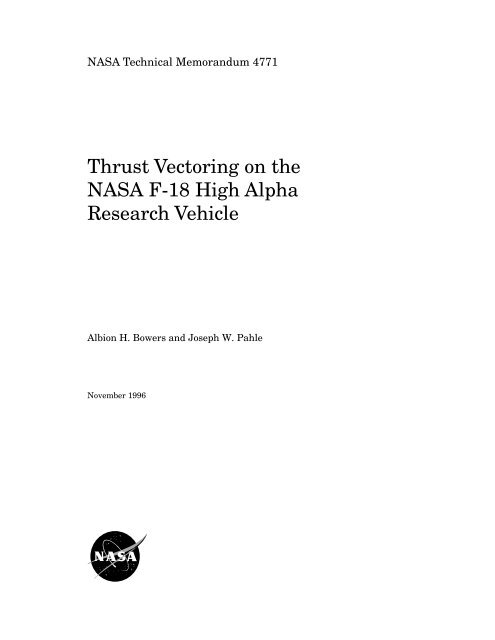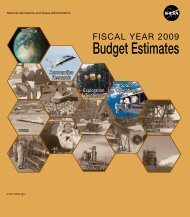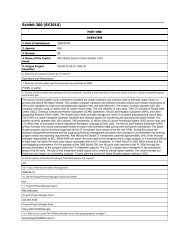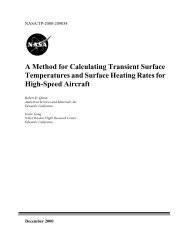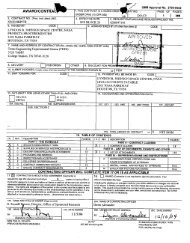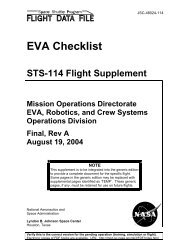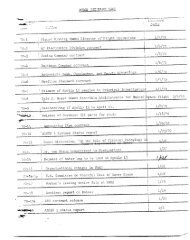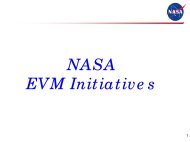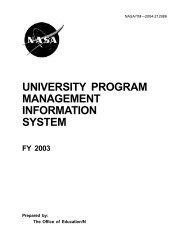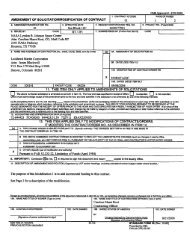Thrust Vectoring on the NASA F-18 High Alpha Research Vehicle
Thrust Vectoring on the NASA F-18 High Alpha Research Vehicle
Thrust Vectoring on the NASA F-18 High Alpha Research Vehicle
Create successful ePaper yourself
Turn your PDF publications into a flip-book with our unique Google optimized e-Paper software.
<strong>NASA</strong> Technical Memorandum 4771<str<strong>on</strong>g>Thrust</str<strong>on</strong>g> <str<strong>on</strong>g>Vectoring</str<strong>on</strong>g> <strong>on</strong> <strong>the</strong><strong>NASA</strong> F-<strong>18</strong> <strong>High</strong> <strong>Alpha</strong><strong>Research</strong> <strong>Vehicle</strong>Albi<strong>on</strong> H. Bowers and Joseph W. PahleNovember 1996
THRUST VECTORING ON THE <strong>NASA</strong> F-<strong>18</strong> HIGH ALPHA RESEARCH VEHICLEAlbi<strong>on</strong> H. BowersJoseph W. Pahle<strong>NASA</strong> Dryden Flight <strong>Research</strong> CenterEdwards, CAABSTRACTInvestigati<strong>on</strong>s into a multiaxis thrust-vectoring system have been c<strong>on</strong>ducted <strong>on</strong> an F-<strong>18</strong>c<strong>on</strong>figurati<strong>on</strong>. These investigati<strong>on</strong>s include ground-based scale-model tests, ground-based fullscaletesting, and flight testing. This thrust-vectoring system has been tested <strong>on</strong> <strong>the</strong> <strong>NASA</strong> F-<strong>18</strong><strong>High</strong> <strong>Alpha</strong> <strong>Research</strong> <strong>Vehicle</strong> (HARV). The system provides thrust vectoring in pitch and yawaxes. Ground-based subscale test data have been ga<strong>the</strong>red as background to <strong>the</strong> flight phase of <strong>the</strong>program. Tests investigated aerodynamic interacti<strong>on</strong> and vane c<strong>on</strong>trol effectiveness. The groundbasedfull-scale data were ga<strong>the</strong>red from static engine runs with image analysis to determinerelative thrust-vectoring effectiveness. Flight tests have been c<strong>on</strong>ducted at <strong>the</strong> <strong>NASA</strong> DrydenFlight <strong>Research</strong> Center. Parameter identificati<strong>on</strong> input techniques have been developed.Individual vanes were not directly c<strong>on</strong>trolled because of a mixer-predictor functi<strong>on</strong> built into <strong>the</strong>flight c<strong>on</strong>trol laws. Combined effects of <strong>the</strong> vanes have been measured in flight and compared tocombined effects of <strong>the</strong> vanes as predicted by <strong>the</strong> cold-jet test data. Very good agreement hasbeen found in <strong>the</strong> linearized effectiveness derivatives.NOMENCLATUREAxialbcC dpvC dyvC AaeroC DaeroC LC lC mC maerototal axial force, lbfspan, ftreference chord, ftlinearized pitch vane effectivenesslinearized yaw vane effectivenessaerodynamic axial force coefficientaerodynamic drag force coefficientaerodynamic lift force coefficientaerodynamic rolling moment coefficientpitching momentaerodynamic pitching moment coefficient
yawαβδ aδ eδ jrmsδ lefδ rδ tefδ vtotal yaw moment, ft/lbfangle of attack, degangle of side slip, degailer<strong>on</strong> deflecti<strong>on</strong>, degelevator deflecti<strong>on</strong>, degjet-turning angle, degleading-edge flap deflecti<strong>on</strong>, degrudder deflecti<strong>on</strong>, degtrailing-edge flap deflecti<strong>on</strong>, degvane deflecti<strong>on</strong>, degρ density of air, slug/ft 3 INTRODUCTIONA str<strong>on</strong>g interest in thrust vectoring 1,2 has led to many experiments designed to incorporatethrust vectoring into current- and next-generati<strong>on</strong> aircraft. Most of <strong>the</strong>se studies have focused <strong>on</strong>vectoring in <strong>the</strong> pitch plane to improve <strong>the</strong> pitch c<strong>on</strong>trol power 3,4 or in <strong>the</strong> yaw plane to improveyaw c<strong>on</strong>trol power. 5–7 Some studies have examined vectoring in <strong>the</strong> pitch and yaw planes. 8–10To date, <strong>on</strong>ly a few research aircraft have flown with <strong>the</strong> capability of vectoring in both pitchand yaw. Two of <strong>the</strong>se aircraft have completed research programs using axisymmetric nozzles withpostexit vanes for thrust vectoring. These two aircraft are <strong>the</strong> U. S. Navy X-31A 11 and <strong>the</strong> <strong>NASA</strong>F-<strong>18</strong> <strong>High</strong> <strong>Alpha</strong> <strong>Research</strong> <strong>Vehicle</strong> (HARV) with a thrust-vectoring c<strong>on</strong>trol system (TVCS)installed. 12–15 Based <strong>on</strong> previous developmental tests, 8 both aircraft selected thrust-vectoringsystems that employed three postexit vanes radially displaced about <strong>the</strong>ir axisymmetric nozzles.Early informati<strong>on</strong> was required to properly characterize an axisymmetric nozzle with postexitexhaust vanes like that applied to <strong>the</strong> <strong>NASA</strong> F-<strong>18</strong> HARV. These data were provided by testingground-based models of <strong>the</strong> F-<strong>18</strong> HARV with <strong>the</strong> TVCS installed. Two aerodynamic interacti<strong>on</strong>tests were performed at <strong>the</strong> <strong>NASA</strong> Langley <strong>Research</strong> Center. The first test was c<strong>on</strong>ducted in <strong>the</strong>Full-Scale Facility 30- by 60-ft wind tunnel. The test characterized <strong>the</strong> aerodynamic interacti<strong>on</strong>effects <strong>on</strong> a full-c<strong>on</strong>figurati<strong>on</strong>, 16 percent–scale F/A-<strong>18</strong> model that were caused by vectoring <strong>the</strong>exhaust plume at low speeds. 16 The sec<strong>on</strong>d test was c<strong>on</strong>ducted in <strong>the</strong> 16-Ft Trans<strong>on</strong>ic Tunnelusing a wingtip-supported 10 percent–scale F/A-<strong>18</strong> model. This test was c<strong>on</strong>ducted betweenMach 0.3 and 0.7 and angles of attack between 0° and 70°, with military-power and fullafterburnernozzles at nozzle pressure ratios (NPRs) between 1.0 and 5.0, 17 to fur<strong>the</strong>r examineaerodynamic interacti<strong>on</strong> effects caused by vectoring <strong>the</strong> exhaust plume.A static cold-jet test was also c<strong>on</strong>ducted at <strong>the</strong> <strong>NASA</strong> Langley 16-Ft Trans<strong>on</strong>ic Tunnel tocharacterize <strong>the</strong> thrust-turning effectiveness of <strong>the</strong> postexit vanes <strong>on</strong> a 14.25 percent–scale nozzle3
model. <strong>18</strong>,19 This test was <strong>on</strong>ly of <strong>the</strong> nozzle and modeled <strong>on</strong>ly <strong>the</strong> internal flow of <strong>the</strong> nozzle and<strong>the</strong> vanes.A static ground test, called <strong>the</strong> “hot loads” test, was c<strong>on</strong>ducted with <strong>the</strong> aircraft after <strong>the</strong>TVCS had been installed at <strong>the</strong> <strong>NASA</strong> Dryden Flight <strong>Research</strong> Center. The aircraft was securedto <strong>the</strong> Edwards Air Force Base Universal Horiz<strong>on</strong>tal <str<strong>on</strong>g>Thrust</str<strong>on</strong>g> Stand. The thrust stand was <strong>on</strong>lycapable of resolving forces in <strong>the</strong> axial directi<strong>on</strong>, and comparis<strong>on</strong>s of <strong>the</strong>se results with <strong>the</strong> coldjettest axial thrust loss data were made. 19 Infrared images of <strong>the</strong> exhaust flow were used toestimate plume-deflecti<strong>on</strong> angles. Hot loads test plume-deflecti<strong>on</strong> infrared estimates were alsocompared to cold-jet test results.Flight tests were also c<strong>on</strong>ducted at <strong>NASA</strong> Dryden. In-flight plume deflecti<strong>on</strong> is difficult tomeasure directly, so indirect methods to estimate thrust-vectoring effectiveness were used. 20–22Parameter identificati<strong>on</strong> input techniques were developed, 23 both pilot-flown and preprogrammedthrough <strong>the</strong> use of an <strong>on</strong>-board excitati<strong>on</strong> system that c<strong>on</strong>trolled <strong>the</strong> postexit vanes. Individualvanes were not directly c<strong>on</strong>trolled because of a mixer-predictor functi<strong>on</strong> built into <strong>the</strong> flightc<strong>on</strong>trol laws. As such, combined effects of <strong>the</strong> vanes were measured in flight and compared tocombined effects of <strong>the</strong> vanes as predicted by <strong>the</strong> cold-jet test data.This paper presents an overview of <strong>the</strong> ground-based tests, results of <strong>the</strong> infrared data of <strong>the</strong>hot loads test of <strong>the</strong> installed TVCS, and estimates of <strong>the</strong> effectiveness of <strong>the</strong> TVCS from in-flightparameter identificati<strong>on</strong>. These full-scale results are compared to <strong>the</strong> subscale tests. All tests ofthis system are now complete, and this report summarizes significant results of <strong>the</strong> full-scale testsin comparis<strong>on</strong> to predicted thrust-vectoring c<strong>on</strong>trol effectiveness.HIGH ALPHA RESEARCH VEHICLE DESCRIPTIONThe F-<strong>18</strong> HARV is a high-performance twin-turbofan jet engine fighter-attack airplane builtby McD<strong>on</strong>nell Douglas Aerospace (St. Louis, Missouri) (fig. 1). 12–15 The HARV has midwingc<strong>on</strong>figurati<strong>on</strong>wings, twin vertical tails canted outwards at 20° from <strong>the</strong> vertical, midmountedhoriz<strong>on</strong>tal tailplanes, and leading-edge extensi<strong>on</strong>s that run forward al<strong>on</strong>g <strong>the</strong> fuselage to near <strong>the</strong>canopy. The engines are General Electric (Lynn, Massachusetts) F404-GE-400 engines rated at10,000 lbf static thrust at sea level in <strong>the</strong> full military-power setting and 16,000 lbf static thrust atsea level in <strong>the</strong> maximum-afterburner setting.The aircraft was modified by <strong>the</strong> additi<strong>on</strong> of a rudimentary TVCS that uses three postexitvanes around each engine. The geometry of <strong>the</strong> TVCS hardware uses three vanes mounted aroundeach engine of <strong>the</strong> F-<strong>18</strong> airplane. Vanes replace <strong>the</strong> standard divergent secti<strong>on</strong> of <strong>the</strong> nozzle andexternal flaps. The c<strong>on</strong>vergent secti<strong>on</strong> of <strong>the</strong> nozzle remains <strong>on</strong> <strong>the</strong> aircraft. The vanes weredesigned to be stowed at –10°, out of <strong>the</strong> exhaust plume. During vectoring maneuvers, amaximum of two vanes <strong>on</strong> any <strong>on</strong>e engine were commanded in c<strong>on</strong>tact with <strong>the</strong> flow at <strong>on</strong>e time,helping to alleviate <strong>the</strong>rmal and load c<strong>on</strong>straints <strong>on</strong> <strong>the</strong> vane system.The thrust-vectoring vanes were c<strong>on</strong>trolled through use of modified flight c<strong>on</strong>trol computersthat allowed <strong>the</strong> basic flight c<strong>on</strong>trol laws to be bypassed with research flight c<strong>on</strong>trol laws in a4
960689Figure 1. Three-view drawing of <strong>the</strong> F-<strong>18</strong> HARV.porti<strong>on</strong> of <strong>the</strong> flight c<strong>on</strong>trol computers called <strong>the</strong> research flight c<strong>on</strong>trol system (RFCS). TheRFCS envelope of <strong>the</strong> aircraft was Mach 0.2–0.7 and initial altitudes of 15,000–35,000 ft, whichwas later expanded to 45,000 ft. The basic F-<strong>18</strong> flight c<strong>on</strong>trol laws resided in <strong>the</strong> 701E (GeneralElectric, Lynn, Massachusetts) porti<strong>on</strong> of <strong>the</strong> flight c<strong>on</strong>trol computers and passed data back andforth to <strong>the</strong> RFCS.The output of <strong>the</strong> c<strong>on</strong>trol laws was a simple command of pitch or yaw vectoring moments. Tomake use of <strong>the</strong>se commanded moments from <strong>the</strong> thrust vectoring, a schedule was devised, called5
<strong>the</strong> mixer-predictor or <strong>the</strong> mixer, where <strong>the</strong> pitch and yaw commands were c<strong>on</strong>verted intoindividual vane deflecti<strong>on</strong>s. Several releases of mixer software were made, and two were carriedto flight (Mixer 1 and Mixer 4.2). Mixer 1 was a cooperative effort between McD<strong>on</strong>nell DouglasAerospace, <strong>NASA</strong> Dryden, and <strong>NASA</strong> Langley. 24 Mixer 4.2 was a cooperative design between<strong>NASA</strong> Langley and <strong>NASA</strong> Dryden. 25The ability to use preprogrammed maneuvers by superimposing moti<strong>on</strong>s over <strong>the</strong> c<strong>on</strong>trolsurface outputs, called <strong>the</strong> <strong>on</strong>-board excitati<strong>on</strong> system, resided within <strong>on</strong>e part of <strong>the</strong> RFCS.The ability to separate <strong>the</strong> individual c<strong>on</strong>trol surface moti<strong>on</strong>s through <strong>the</strong> <strong>on</strong>-board excitati<strong>on</strong>system allowed reducti<strong>on</strong> in surface moti<strong>on</strong> correlati<strong>on</strong> and reduced uncertainty in <strong>the</strong> finaleffectiveness estimates.THRUST-VECTORING CONTROL SYSTEM DESCRIPTIONFigure 2 shows <strong>the</strong> vane c<strong>on</strong>figurati<strong>on</strong> for <strong>the</strong> left engine <strong>on</strong>ly. The upper-vane centerline is5° outboard of <strong>the</strong> vertical plane. The outboard-vane centerline is 1<strong>18</strong>° counterclockwise from <strong>the</strong>upper-vane centerline. The outboard-vane centerline to <strong>the</strong> lower-vane centerline measurementis 103.5° counterclockwise. The lower-vane centerline to <strong>the</strong> upper-vane centerline measurementis 138.5° counterclockwise. The upper vane was larger than <strong>the</strong> outer or lower vanes (fig. 3)because of <strong>the</strong> uneven radial spacing caused by structural c<strong>on</strong>siderati<strong>on</strong>s. The exhaust-plume sideof each vane is c<strong>on</strong>cave, with each vane forming part of a spherical surface of 36 in. radius axiallyand laterally.The total amount of turning of <strong>the</strong> jet exhaust plume, or jet-turning angle, is defined as <strong>the</strong>root mean square of <strong>the</strong> equivalent thrust-vector deflecti<strong>on</strong> angle in pitch and yaw as measured by<strong>the</strong> resultant force (fig. 4). The axial thrust loss for <strong>the</strong> deflected flow is defined as <strong>the</strong> loss in <strong>the</strong>Upper vaneMaximum afterburner5˚138.5˚1<strong>18</strong>˚Military powerLowervaneOuter vanenozzle 348 in 2 103.5˚960693Figure 2. <str<strong>on</strong>g>Thrust</str<strong>on</strong>g>-vectoring c<strong>on</strong>trol system end-view of <strong>the</strong> left engine looking forward. Radial vaneincluded angles are displayed. All vanes shown fully extended into <strong>the</strong> plume. The right engine isa mirror image of <strong>the</strong> left.6
5.<strong>18</strong>5 in.Radius = 36 in.9.120 in.20 in.20 in.Lower andouter vanesUpper vane12.591 in.12.420 in.15 in.20 in.Area = 263.64 in 2 Area = 358.76 in 2 960694 960097Figure 3. Dimensi<strong>on</strong>s for flight vanes.EnginenozzleAxial force(deflected flow)Undeflectedthrust vectorEnginecenterlineResultantforce vectorJet turningangleNormalized axial thrust =Axial forceUndeflectedUndeflected thrust thrust magnitude960707Figure 4. Schematic of jet-turning angle and axial thrust loss definiti<strong>on</strong>s.thrust of <strong>the</strong> axial force when compared to <strong>the</strong> undeflected thrust. The normalized axial thrust is<strong>the</strong> absolute value of <strong>the</strong> axial force divided by <strong>the</strong> absolute value of <strong>the</strong> undeflected thrust.TESTING AND MODELSSeveral tests were c<strong>on</strong>ducted to characterize thrust vectoring <strong>on</strong> <strong>the</strong> F-<strong>18</strong> HARV. These testswere two subscale aerodynamic interacti<strong>on</strong> tests, <strong>on</strong>e of which is discussed here; a subscalecold-jet test; a full-scale hot loads test; and <strong>the</strong> flight test (table 1).The 16 percent–scale aerodynamic interacti<strong>on</strong> model was tested in <strong>the</strong> 30- by 60-ft windtunnel at <strong>NASA</strong> Langley. 16 This particular F/A-<strong>18</strong> model was used because, being a free-flightmodel, it already had ducting for <strong>the</strong> inlets, exhausts, and high-pressure air built into <strong>the</strong> design. 47
Table 1. Test matrix.Test Model Scale CommentsAero 16 F-<strong>18</strong> HARV 16 percent External flow,n<strong>on</strong>metric nozzlesAero 17 F-<strong>18</strong> HARV 10 percent Internal/external flow,n<strong>on</strong>metric wingCold jet 16,<strong>18</strong> Left nozzle 14.25 percent Internal flowHot loads 19 F-<strong>18</strong> HARV Full Static ground enginerun testFlight parameter F-<strong>18</strong> HARV Full Parameter identificati<strong>on</strong>identificati<strong>on</strong> 23,30 flight testThe model, designed for use in free-flight testing, was of very light c<strong>on</strong>structi<strong>on</strong>, which resultedin tests being c<strong>on</strong>ducted at low dynamic pressures to prevent structural damage. The radiallocati<strong>on</strong> of <strong>the</strong> vanes <strong>on</strong> <strong>the</strong> model was oriented in <strong>the</strong> same way as for <strong>the</strong> aircraft. The hingeswere located to allow correct vane positi<strong>on</strong> and deflecti<strong>on</strong> angles. A spin chute canister was alsoincluded in <strong>the</strong> modificati<strong>on</strong>s to <strong>the</strong> model. The primary difference between <strong>the</strong> aircraft and <strong>the</strong>aerodynamic interacti<strong>on</strong> model c<strong>on</strong>figurati<strong>on</strong> was <strong>the</strong> nozzle areas. The nozzles used in <strong>the</strong>aerodynamic interacti<strong>on</strong> test were 13.31 in 2 in area, which corresp<strong>on</strong>ds to a 520-in 2 nozzle area<strong>on</strong> <strong>the</strong> full-size F-<strong>18</strong> airplane. The tailpipe area nominally used during flight tests is 348 in 2 in <strong>the</strong>thrust-vectoring envelope. Differences between <strong>the</strong> aircraft and <strong>the</strong> low-speed aerodynamicinteracti<strong>on</strong> model also included AIM-9 missiles (Ray<strong>the</strong><strong>on</strong>, Bedford, Massachusetts) in place ofresearch airdata wingtip probes, <strong>the</strong> omissi<strong>on</strong> <strong>on</strong> <strong>the</strong> model of video camera fairings used <strong>on</strong> <strong>the</strong>aircraft, and <strong>the</strong> lack of incorporati<strong>on</strong> <strong>on</strong> <strong>the</strong> wind-tunnel model of <strong>the</strong> horiz<strong>on</strong>tal stabilizer areareducti<strong>on</strong> (1.6 percent in area) for thrust-vectoring fairing clearance used <strong>on</strong> <strong>the</strong> aircraft.The 10 percent–scale test was c<strong>on</strong>ducted at NPRs between 1.0 and 5.0, free-stream Machnumbers between 0.3 and 0.7, and angles of attack between 0° and 70°. 17 This model waswingtip-supported and differed from <strong>the</strong> flight vehicle c<strong>on</strong>figurati<strong>on</strong> by having faired-over inlets,nose strakes, and larger leading-edge extensi<strong>on</strong> slots. Significant modificati<strong>on</strong> was undertaken tomake <strong>the</strong> 10 percent–scale F/A-<strong>18</strong> model metric aft fuselage area geometrically resemble<strong>the</strong> HARV c<strong>on</strong>figurati<strong>on</strong> with postexit vanes and <strong>the</strong>ir associated actuator fairings and <strong>the</strong> spinchute canister.A 14.25 percent–scale model of <strong>the</strong> left exhaust nozzle with postexit vanes of <strong>the</strong> F-<strong>18</strong> HARVaircraft was tested. 16,<strong>18</strong> The objective of this static test was to ga<strong>the</strong>r a comprehensive set of datafrom direct jet-turning effectiveness of <strong>the</strong> postexit vanes. Data were ga<strong>the</strong>red with a force andmoment balance. The cold-jet test was performed in <strong>the</strong> <strong>NASA</strong> Langley 16-ft Trans<strong>on</strong>ic Tunnel.The comprehensive data set from <strong>the</strong> cold-jet test formed <strong>the</strong> baseline of comparis<strong>on</strong> to allsubsequent tests. Two nozzle sizes were used in this test. These sizes corresp<strong>on</strong>ded to militarypowerand maximum-afterburner nozzles at a nominal flight c<strong>on</strong>diti<strong>on</strong> in <strong>the</strong> thrust-vectoring8
envelope of <strong>the</strong> aircraft. The vane angles were measured with simple protractors, and <strong>the</strong>irpositi<strong>on</strong>s varied from –10° to 30° deflecti<strong>on</strong> (approximately 0.5° accuracy). The NPR variati<strong>on</strong>swere from 1.0 (no flow) to 6.0 for most test cases.The static test of <strong>the</strong> TVCS installed <strong>on</strong> <strong>the</strong> aircraft with running engines was called <strong>the</strong> “hotloads” test. The hot loads test was <strong>the</strong> first test of <strong>the</strong> F-<strong>18</strong> HARV with <strong>the</strong> TVCS installed andwas c<strong>on</strong>ducted at <strong>NASA</strong> Dryden using <strong>the</strong> thrust stand at Edwards AFB. One research objectiveof this porti<strong>on</strong> of <strong>the</strong> study was to determine <strong>the</strong> feasibility of using digitized infrared imaging asa technique to determine thrust-vectoring effectiveness. Infrared imaging provided an ability todirectly compare exhaust-plume deflecti<strong>on</strong>s to <strong>the</strong> cold-jet test ground facility predicti<strong>on</strong>s. With<strong>the</strong> inability to measure actual vectoring forces developed during <strong>the</strong> hot loads test, infraredimaging could offer an alternative to validate <strong>the</strong> flight hardware implementati<strong>on</strong> of thrustvectoring. Test c<strong>on</strong>diti<strong>on</strong>s of <strong>the</strong> hot loads tests included military-power, midafterburner-power(with a nozzle exit area of 56 percent), and maximum-afterburner nozzles with all combinati<strong>on</strong>sof single-vane and two-vane equal deflecti<strong>on</strong>s. The aircraft was secured to <strong>the</strong> thrust stand, whichcould directly measure thrust loss during <strong>the</strong> test. 19Flight tests of <strong>the</strong> F-<strong>18</strong> HARV were c<strong>on</strong>ducted at <strong>NASA</strong> Dryden. Parameter identificati<strong>on</strong>maneuvers were used to determine stability and c<strong>on</strong>trol coefficients using <strong>the</strong> error outputtechnique and pEst code. 20–22 One parameter extracted from <strong>the</strong> flight data was thrust-vectoringc<strong>on</strong>trol effectiveness, of which some results have been reported. 23,26–28 This parameterestimati<strong>on</strong> technique does not differentiate between thrust-vectoring forces and moments and <strong>the</strong>aerodynamic interacti<strong>on</strong>s caused by thrust vectoring. As a c<strong>on</strong>sequence, <strong>the</strong>se two parameters areinseparable and cannot be independently identified. During <strong>the</strong> F-<strong>18</strong> HARV flight testing of <strong>the</strong>sedata, however, <strong>the</strong> aerodynamic interacti<strong>on</strong> was c<strong>on</strong>sidered to be very low because of <strong>the</strong>low–dynamic pressures level-flight 1-g c<strong>on</strong>diti<strong>on</strong> used during <strong>the</strong> parameter identificati<strong>on</strong>maneuvers. As a result, <strong>the</strong> predominant characteristic estimated is that of <strong>the</strong> thrust-vectoringeffectiveness. The low–dynamic pressure data are a result of all test points being flown in 1-glevel flight and high angle of attack c<strong>on</strong>fining <strong>the</strong> aircraft to relatively slow flight. Fur<strong>the</strong>rcomplicating <strong>the</strong> issue is <strong>the</strong> mixer functi<strong>on</strong> in <strong>the</strong> flight c<strong>on</strong>trol laws preventing individual vanesfrom being c<strong>on</strong>trolled. As a result, a collective vane functi<strong>on</strong> is identified, and estimates ofvectoring c<strong>on</strong>trol power from flight are made and <strong>the</strong>n compared to equivalent collective vaneeffectiveness from <strong>the</strong> cold-jet test data.THRUST-VECTORING RESEARCH RESULTSThe research c<strong>on</strong>ducted was divided into four areas. These four areas are: aerodynamicinteracti<strong>on</strong> tests, <strong>the</strong> static cold-jet test, <strong>the</strong> static engine run (“hot loads”) test of <strong>the</strong> installedsystem <strong>on</strong> <strong>the</strong> aircraft, and <strong>the</strong> flight test of <strong>the</strong> aircraft.Aerodynamic Interacti<strong>on</strong> TestsAerodynamic interacti<strong>on</strong> with thrust vectoring was an unknown; <strong>the</strong>refore, two tests werec<strong>on</strong>ducted to investigate aerodynamic interacti<strong>on</strong>. The tests were a 16 percent–scale low-speedtest with a subs<strong>on</strong>ic ejector exhaust c<strong>on</strong>ducted in <strong>the</strong> <strong>NASA</strong> Langley 30- by 60-ft low-speed wind9
tunnel and a 10 percent–scale test with a s<strong>on</strong>ic nozzle c<strong>on</strong>ducted in <strong>the</strong> 16-ft Trans<strong>on</strong>ic Tunnel at<strong>NASA</strong> Langley.Aerodynamic forces and moments <strong>on</strong> <strong>the</strong> F-<strong>18</strong> HARV with <strong>the</strong> installed TVCS are taken at<strong>the</strong> 0.24-chord positi<strong>on</strong>. <str<strong>on</strong>g>Vectoring</str<strong>on</strong>g> directi<strong>on</strong> definiti<strong>on</strong>s for plume deflecti<strong>on</strong>s are as follows: up isnegative, down is positive, right is negative, and left is positive. When <strong>the</strong> thrust-vectoring vanesare not installed, <strong>the</strong> nozzle c<strong>on</strong>figurati<strong>on</strong> is defined as unvectored. For any <strong>on</strong>e engine, when twovanes are deflected into <strong>the</strong> exhaust, <strong>the</strong> third vane is retracted at –10° deflecti<strong>on</strong> and is referred toas <strong>the</strong> retracted vane.Significant findings of <strong>the</strong> low-speed test were that forces were mildly adverse and momentswere mildly proverse. For <strong>the</strong>se aerodynamic interacti<strong>on</strong> tests, <strong>the</strong> plume deflecti<strong>on</strong>s were–17° up, 14° down, and –9° right. A change in lift coefficient of approximately 0.1 caused byvectoring in <strong>the</strong> pitch plane was found over <strong>the</strong> entire angle-of-attack range (fig. 5) for <strong>the</strong> testedc<strong>on</strong>diti<strong>on</strong>. A change in pitching moment of approximately 0.1 was found near 0° angle of attack,decreasing to 0 increment in moment near 65° angle of attack with vectoring in <strong>the</strong> pitchplane (fig. 6). <str<strong>on</strong>g>Vectoring</str<strong>on</strong>g> was intended primarily as a moment-producing effector, so vectoring <strong>the</strong>plume up would cause a noseup pitching moment. But <strong>the</strong> exhaust plume vectored up woulddecrease <strong>the</strong> lift coefficient in <strong>the</strong> adverse directi<strong>on</strong> while increasing <strong>the</strong> pitching momentcoefficient in <strong>the</strong> proverse directi<strong>on</strong>. This behavior is analogous to a blown flap.The 10 percent–scale test 17 was c<strong>on</strong>ducted to investigate aerodynamic interacti<strong>on</strong>s over arepresentative c<strong>on</strong>figurati<strong>on</strong>. The results of <strong>the</strong> 10 percent–scale test expanded <strong>the</strong> database andsupported previous c<strong>on</strong>clusi<strong>on</strong>s of <strong>the</strong> 16 percent–scale test, in particular that substantial gains inc<strong>on</strong>trollability are provided by a multiaxis thrust-vectoring capability.2.52.01.5Vectordirecti<strong>on</strong>UnvectoredUpRightDownC L1.0.50– .50 10 20 30 40 50 60 70Angle of attack, deg960708Figure 5. Pitching moment coefficient as a functi<strong>on</strong> of angle of attack, with thrust vectoring varyingdirecti<strong>on</strong>; δ e = –12°, δ a = 0°, δ r = 0°, and C t = 0.8.10
.4.3.2Vectordirecti<strong>on</strong>UnvectoredUpRightDown.1C m0– .1– .2– .30 10 20 30 40 50 60 70Angle of attack, deg960709Figure 6. Pitching moment coefficient as a functi<strong>on</strong> of angle of attack, with thrust vectoring varyingdirecti<strong>on</strong>; δ lef = 34°, δ tef = 0°, δ e = –12°, δ a = 0°, δ r = 0°, and C t = 0.8.<str<strong>on</strong>g>Thrust</str<strong>on</strong>g>-<str<strong>on</strong>g>Vectoring</str<strong>on</strong>g> Effectiveness TestsAlthough many tests were c<strong>on</strong>ducted to examine <strong>the</strong> effectiveness of thrust vectoring, threetests in particular are examined here. The tests in this secti<strong>on</strong> are <strong>the</strong> cold-jet test, <strong>the</strong> hot loadstest, and <strong>the</strong> in-flight parameter identificati<strong>on</strong> tests.Cold-Jet TestThe objective of <strong>the</strong> cold-jet test was to ga<strong>the</strong>r a comprehensive set of data of <strong>the</strong> directjet-turning effectiveness of <strong>the</strong> postexit vanes. Data were ga<strong>the</strong>red with a force and momentbalance, and plume-turning angles were inferred from <strong>the</strong> force and moment data. Because of <strong>the</strong>n<strong>on</strong>axisymmetric installati<strong>on</strong> of <strong>the</strong> vanes, pitch and yaw deflecti<strong>on</strong> angles are not discussed; <strong>the</strong>total root mean square of <strong>the</strong> pitch and yaw vane deflecti<strong>on</strong>s is used instead.C<strong>on</strong>trol effectiveness is defined as <strong>the</strong> angle through which <strong>the</strong> exhaust plume is turned by <strong>the</strong>vanes, regardless of <strong>the</strong> ultimate forces or moments produced. This effectiveness definiti<strong>on</strong> is animportant distincti<strong>on</strong>, as <strong>the</strong> thrust available to be turned is much larger in maximum-afterburnernozzle than in military-power nozzle.The large upper vane produced greater plume deflecti<strong>on</strong> than <strong>the</strong> two small (lower and outer)vanes did. In <strong>the</strong> military-power nozzle case, <strong>the</strong> large vane was 50 percent more effective than<strong>the</strong> small vanes were; and in <strong>the</strong> maximum-afterburner nozzle case, <strong>the</strong> large vane was 25 percentmore effective than <strong>the</strong> small vanes. The vanes did not become effective until <strong>the</strong>y impinged <strong>on</strong>11
<strong>the</strong> edge of <strong>the</strong> exhaust plume at approximately 15° vane deflecti<strong>on</strong> for military-power nozzle andapproximately 10° deflecti<strong>on</strong> for maximum-afterburner nozzle for <strong>the</strong> selected NPR. This vaneineffectiveness results in larger dead band for <strong>the</strong> smaller military-power nozzle than for <strong>the</strong>larger maximum-afterburner nozzle. The slopes of <strong>the</strong> vane deflecti<strong>on</strong>–to–plume deflecti<strong>on</strong>curves are also close between <strong>the</strong> two tested nozzles, with <strong>the</strong> military-power nozzle having aslightly larger slope than <strong>the</strong> maximum-afterburner nozzle.Also as expected, <strong>the</strong> NPR largely affects effectiveness. As <strong>the</strong> exhaust plume expansi<strong>on</strong>increases with increased NPR, <strong>the</strong> vanes become effective at decreased vane deflecti<strong>on</strong>s (fig. 9).The slope of <strong>the</strong> various curves are relatively insensitive to NPR variati<strong>on</strong> in <strong>the</strong> 15°–20° vanedeflecti<strong>on</strong> regi<strong>on</strong>. These data are for all single-vane deflecti<strong>on</strong>s with <strong>the</strong> military-power nozzle atan NPR of 2.Two vanes used simultaneously show greater effectiveness (fig. 10) for <strong>the</strong> same deflecti<strong>on</strong>when compared with single vanes (fig. 7). Effectiveness increased to approximately 100 percentin this case. Also, two vanes radially spaced closer toge<strong>the</strong>r (fig. 3) show greater effectivenessthan vanes spaced fur<strong>the</strong>r apart. This difference could be explained by flow “leaking” through <strong>the</strong>gap between vanes, and a smaller gap will leak less. The lower and upper vanes (138.5° radialspacing (fig. 3)) were less effective than <strong>the</strong> lower and outer vanes (1<strong>18</strong>° radial spacing (fig. 3)).Cold-jet test results determined that vane spacing is a very str<strong>on</strong>g and important parameter, moreimportant than vane size. These data are for <strong>the</strong> military-power nozzle at an NPR of 2.Axial force loss was ano<strong>the</strong>r measurement of <strong>the</strong> cold-jet test. Axial force loss dataare normalized axial thrust. In all cases, increases in vane deflecti<strong>on</strong> caused greater axial forceloss (fig. 11). In this sample case of single-vane deflecti<strong>on</strong>s, <strong>the</strong> large upper vane caused <strong>the</strong>lowest normalized axial force (0.82) at 30° vane deflecti<strong>on</strong>, with <strong>the</strong> two equally sized vanesproducing equal amounts of thrust loss (0.87) within experimental error. These results are for <strong>the</strong>military-power nozzle case with an NPR of 2.The extreme edge of <strong>the</strong> plume-deflecti<strong>on</strong> envelope in pitch and yaw is shown with variati<strong>on</strong>in NPR (fig. 12) for <strong>the</strong> maximum-afterburner nozzle for vane deflecti<strong>on</strong>s of 30°. The extremeenvelope is found by holding at least <strong>on</strong>e vane at 30° deflecti<strong>on</strong> and at least <strong>on</strong>e o<strong>the</strong>r vaneat –10°. Retracted vane interference effects can be observed at three of <strong>the</strong> corners, near pitch andyaw coordinates (11, 9), (–25, –3), and (16, –20). The loss of turning effectiveness caused byincreasing NPR is most evident near <strong>the</strong>se corners, especially near coordinate (11, 9) in pitch andyaw. The o<strong>the</strong>r three corners, (<strong>18</strong>, –3), (–7, –10) and (–9, 9), are single-vane deflecti<strong>on</strong> cornersand show no retracted vane interference effects. The data shown are for <strong>the</strong> left engine <strong>on</strong>ly anddisplay <strong>the</strong> actual pitch and yaw plume-deflecti<strong>on</strong> angles, not <strong>the</strong> plume-deflecti<strong>on</strong> angle to <strong>the</strong>centerline as previously shown (figs. 7 to 11).Full-Scale Static <str<strong>on</strong>g>Thrust</str<strong>on</strong>g> Test Infrared DataInfrared imaging can visualize <strong>the</strong> hot exhaust plume of a jet engine. Infrared intensity isrelated to temperature, although in a n<strong>on</strong>linear functi<strong>on</strong>. The infrared representati<strong>on</strong> of <strong>the</strong>exhaust plumes, however, could be digitized and treated ma<strong>the</strong>matically to calculate plumedeflecti<strong>on</strong>s. Reducing <strong>the</strong> data obtained during hot loads testing to simple digital values with nomenti<strong>on</strong> of infrared intensity or wavelength and circumventing classificati<strong>on</strong> of <strong>the</strong> results waspossible. The fundamental assumpti<strong>on</strong> is that <strong>the</strong> infrared intensity and <strong>the</strong> plume profilesare equivalent.12
353025OutervaneUpper vaneLeft engineLowervaneVaneUpperOuterLowerδ jrms ,deg20151050– 10 – 5 0 5 10 15 20 25 30δ v , deg960710Figure 7. Jet-turning angle as a functi<strong>on</strong> of single-vane deflecti<strong>on</strong> for all three vanes with <strong>the</strong>military-power nozzle and NPR = 2.353025OutervaneUpper vaneLeft engineLowervaneVaneUpperOuterLowerδ jrms ,deg20151050– 10 – 5 0 5 10 15 20 25 30δ v , deg960711Figure 8. Jet-turning angle as a functi<strong>on</strong> of single-vane deflecti<strong>on</strong> for all three vanes with <strong>the</strong>maximum-afterburner nozzle and NPR = 2.13
353025OutervaneUpper vaneLeft engineLowervaneNPR23456δ jrms ,deg20151050– 10 – 5 0 5 10 15 20 25 30δ v , deg960712Figure 9. Jet-turning angle as a functi<strong>on</strong> of single-vane deflecti<strong>on</strong> (upper) and varying NPR with<strong>the</strong> military-power nozzle.35Upper vane3025OutervaneLeft engineLowervaneδ jrms ,deg2015105VaneUpper and outerOuter and lowerLower and upper0– 10 – 5 0 5 10 15 20 25 30δ v , deg960713Figure 10. Jet-turning angle as a functi<strong>on</strong> of two-angle equal deflecti<strong>on</strong>s for all two-vanecombinati<strong>on</strong>s with <strong>the</strong> military-power nozzle and NPR = 2.14
1.051.00VaneUpperOuterLower.95Normalizedaxialthrust.90.85Upper vane.80.75OutervaneLeft engineLowervane.70– 10 – 5 0 5 10δ v , deg15 20 25 30960714Figure 11. Normalized axial force thrust loss as a functi<strong>on</strong> of vane deflecti<strong>on</strong> angle for all singlevanedeflecti<strong>on</strong>s with <strong>the</strong> military-power nozzle and NPR = 2.– 30Uppervane(– 25, – 3)– 20OutervaneLeft engineLowervane– 10δ p ,deg0(11, 9)1020NPR23456(16, – 20)3030 20 10 0 – 10 – 20 – 30δ y , deg960715Figure 12. Maximum jet-turning angle envelope, in pitch and yaw, where at least <strong>on</strong>e vane isdeflected 30°. Maximum-afterburner nozzle and varying NPR showing retracted vane interferencenear corners with two-vane equal deflecti<strong>on</strong>s. Symbols omitted for clarity.15
Limitati<strong>on</strong>s of this technique are that <strong>the</strong> data are <strong>on</strong>ly two-dimensi<strong>on</strong>al. Geometric setup of<strong>the</strong> camera was carefully aligned with <strong>the</strong> plane of <strong>the</strong> exhaust nozzles and <strong>the</strong> exhaust plumes sothat metric data could be made from <strong>the</strong> infrared data. An additi<strong>on</strong>al limitati<strong>on</strong> is that in caseswhere multiple plumes exist, rec<strong>on</strong>ciling <strong>the</strong> resultant from <strong>the</strong> individual plumes is difficult.Five test c<strong>on</strong>diti<strong>on</strong>s were selected. These test c<strong>on</strong>diti<strong>on</strong>s were: lower-vane deflecti<strong>on</strong>variati<strong>on</strong>s in military power, lower-vane deflecti<strong>on</strong> variati<strong>on</strong>s in midafterburner power (a nozzleexit area of 56 percent), upper-vane deflecti<strong>on</strong> variati<strong>on</strong>s at maximum afterburner, equal lowerandouter-vane deflecti<strong>on</strong> variati<strong>on</strong>s at military power, and equal lower- and outer-vane deflecti<strong>on</strong>variati<strong>on</strong>s at midafterburner power.The process to ga<strong>the</strong>r data and analyze each test c<strong>on</strong>diti<strong>on</strong> was as follows: <strong>on</strong>ly <strong>on</strong>e engine wasactive in each test, and <strong>the</strong> o<strong>the</strong>r engine was at idle. The idle c<strong>on</strong>diti<strong>on</strong> resulted in no significantsignature in <strong>the</strong> final images, so no attempt was made to subtract <strong>the</strong> idle plume from <strong>the</strong> image.Some background data did exist, however, which tended to bias results to <strong>the</strong> middle of <strong>the</strong> image.This background was removed by simply setting an artificially high threshold just above <strong>the</strong> levelof <strong>the</strong> background. This background is actual signal and not noise in <strong>the</strong> data. Noise within <strong>the</strong>infrared data was not a problem. Typical variati<strong>on</strong>s that could be ascribed to noise were muchlower than <strong>the</strong> level of <strong>the</strong> signal, with <strong>the</strong> signal-to-noise ratio being approximately 50:1.Approximately 5 sec of stabilized data were recorded at each test point, resulting in approximately63 frames of data. These 63 data sets were averaged for <strong>the</strong> final analysis.After capturing <strong>the</strong> digital data, <strong>the</strong> data were c<strong>on</strong>verted to an alphanumeric format that couldbe easily manipulated. The format corresp<strong>on</strong>ded to rows and columns of <strong>the</strong> pixels from <strong>the</strong>captured data (fig. 13). (“Row” and “column” refer to <strong>the</strong> alphanumeric representati<strong>on</strong> of <strong>the</strong> datamanipulati<strong>on</strong> and not to <strong>the</strong> physical geometric presentati<strong>on</strong> of <strong>the</strong> pixels if <strong>the</strong> data werereassembled to make a photographic image as in <strong>the</strong> figure.) By examining each column and row280columnsScreen has 1:1 aspect ratioPixel has 2:1 aspect ratio140 rows960716Figure 13. The layout of <strong>the</strong> rows and columns in <strong>on</strong>e frame of infrared data.16
individually, curves of infrared intensity were generated. Routines were c<strong>on</strong>structed to integrate<strong>the</strong> areas under <strong>the</strong> curves and provide weighted averages of <strong>the</strong> curves. Simple calculati<strong>on</strong>sprovided <strong>the</strong> centroid of each area corresp<strong>on</strong>ding to <strong>the</strong> representative column. Plotting <strong>the</strong>secolumns gives a graphical representati<strong>on</strong> of <strong>the</strong> exhaust plume infrared intensity curves and <strong>the</strong>plume distributi<strong>on</strong> (fig. 14). Comparing centroids of individual plume curves with vane deflecti<strong>on</strong>to centroids of undeflected plumes provides a direct measurement of <strong>the</strong> plume-deflecti<strong>on</strong> angle.60005000Col80901001204000Measuredinfraredintensity3000200010000 50 100 150 200 250Row numbersFigure 14. Typical distributi<strong>on</strong>s of infrared intensity in vertical secti<strong>on</strong>s of <strong>on</strong>e frame of data.960717A trapezoidal integrati<strong>on</strong> was applied to each column of pixels to find <strong>the</strong> area under eachcurve. The area of each trapezoid is given as:∫x i + 1x if( x)dx. f( x i ) + f( x i + 1 )= --------------------------------------- ( ∆ x ) =2∆x----- ( f2 i + f i + 1 )(1)Because each vertical column of pixels is exactly <strong>the</strong> same width, <strong>the</strong> calculati<strong>on</strong> is given as:∫x nx 1f( x)dxn. ∆x= ∑ ----- ( f2 i + f i + 1 )i = 1(2)When <strong>the</strong> centroid of each area is found, it is stored as <strong>the</strong> centroid of that column. Eachcolumn is treated likewise, and <strong>the</strong> complete figure of geometric plume centroids can be plottedfor each vane deflecti<strong>on</strong> case (fig. 15). The low or negative vane deflecti<strong>on</strong>s with small variati<strong>on</strong>sin plume deflecti<strong>on</strong> show little or no potential effectiveness.17
23022021025°20°15°10°5°0°– 5°– 10°Plumecenterlinelocati<strong>on</strong>,row number200190<strong>18</strong>017016060 70 80 90 100 110 120 130 140Column numberFigure 15. Typical plot of <strong>the</strong> loci of <strong>the</strong> centroids of vertical secti<strong>on</strong>s of data, or calculatedplume centerlines.9607<strong>18</strong>Assuming <strong>the</strong> locus of centroids is equal to <strong>the</strong> <strong>the</strong>oretical plume centerline gives <strong>the</strong>deflecti<strong>on</strong> angles. Using <strong>the</strong> raw loci in such a manner and plotting <strong>the</strong>m was referred to as <strong>the</strong><strong>on</strong>e-regi<strong>on</strong> technique.The <strong>on</strong>e-regi<strong>on</strong> technique was modified by c<strong>on</strong>sidering <strong>the</strong> area above and below <strong>the</strong>centerline of <strong>the</strong> n<strong>on</strong>deflected plume as separate areas. Weighted averages of <strong>the</strong> two areas weremade to determine <strong>the</strong> mean plume centerline when <strong>the</strong> plume was split, as in two-vane deflecti<strong>on</strong>cases. This sec<strong>on</strong>d method was called <strong>the</strong> two-regi<strong>on</strong> technique. The two-regi<strong>on</strong> technique wasdeveloped to handle <strong>the</strong> complex flow structures resulting from two-vane equal deflecti<strong>on</strong>s into<strong>the</strong> flow. In <strong>the</strong>se cases, large sec<strong>on</strong>dary jets were found, and <strong>the</strong> results of <strong>the</strong> <strong>on</strong>e-regi<strong>on</strong>technique were poor. As <strong>the</strong> geometric setup of <strong>the</strong> infrared system could <strong>on</strong>ly measure angles inpitch <strong>on</strong>ly, <strong>the</strong> plume was assumed to move in <strong>the</strong> line of acti<strong>on</strong> directly opposite to <strong>the</strong> vaneradial angle. By using this assumpti<strong>on</strong>, <strong>the</strong> angle of <strong>the</strong> plume could be estimated in yaw.Comparis<strong>on</strong> of hot loads test infrared data with <strong>the</strong> <strong>NASA</strong> Langley cold-jet test data showsvarying correlati<strong>on</strong>s for many c<strong>on</strong>diti<strong>on</strong>s. Examples are for <strong>the</strong> lower-vane deflecti<strong>on</strong> withmilitary-power nozzle (fig. 16), lower-vane deflecti<strong>on</strong> with midafterburner-power nozzle(fig. 17), upper-vane deflecti<strong>on</strong> with maximum-afterburner nozzle (fig. <strong>18</strong>), lower- and outervanedeflecti<strong>on</strong>s with military-power nozzle (fig. 19), and lower- and outer-vane deflecti<strong>on</strong>s withmidafterburner-power nozzle (fig. 20).Differences between <strong>the</strong> two analysis techniques, <strong>on</strong>e-regi<strong>on</strong> and two-regi<strong>on</strong>, were small forlower-vane deflecti<strong>on</strong> in military-power setting (fig. 16) and were larger for midafterburner-powersetting (fig. 17). The two techniques did produce varying results. Military-power setting and<strong>18</strong>
single-vane deflecti<strong>on</strong> worked well with <strong>the</strong> <strong>on</strong>e-regi<strong>on</strong> method when compared to <strong>the</strong> cold-jet testresults (fig. 16). In <strong>the</strong> midafterburner-power with two-vane deflecti<strong>on</strong> case, <strong>the</strong> <strong>on</strong>e-regi<strong>on</strong>method also seemed to match <strong>the</strong> cold-jet test data better, within 2° for most of <strong>the</strong> range (fig. 20).The two-regi<strong>on</strong> method seemed to match cold-jet test data best with <strong>the</strong> midafterburner-powersetting and single-vane deflecti<strong>on</strong> (fig. 17), although not as well as a single vane in military power.And in <strong>the</strong> case of military power with two vanes, most of <strong>the</strong> operating regi<strong>on</strong> of <strong>the</strong> cold-jet testdata is matched better by <strong>the</strong> two-regi<strong>on</strong> technique (fig. 19). Trends in each of <strong>the</strong>se cases are welldefined and correlate well, but absolute values of plume turning–effectiveness results are mixed.86One regi<strong>on</strong>Two regi<strong>on</strong>Cold jetPlumedeflecti<strong>on</strong>,deg420– 20 5 10 15 20 25Vane deflecti<strong>on</strong>, deg960719Figure 16. Lower vane deflecti<strong>on</strong> with nozzle in military power for <strong>on</strong>e-regi<strong>on</strong> and two-regi<strong>on</strong>infrared compared with cold-jet test data.1210One regi<strong>on</strong>Two regi<strong>on</strong>Cold jet8Plumedeflecti<strong>on</strong>,deg64205 10 15 20 25Vane deflecti<strong>on</strong>, deg960720Figure 17. Lower vane deflecti<strong>on</strong> with nozzle in midafterburner for <strong>on</strong>e-regi<strong>on</strong> and two-regi<strong>on</strong>infrared compared with cold-jet test data.19
20One regi<strong>on</strong>Cold jet15Measuredplumedeflecti<strong>on</strong>,deg1050 5 10 15 20 25Vane deflecti<strong>on</strong>, deg960721Figure <strong>18</strong>. Upper vane deflecti<strong>on</strong> with nozzle in maximum afterburner for <strong>on</strong>e-regi<strong>on</strong> infraredcompared to cold-jet test data.2520One regi<strong>on</strong>Two regi<strong>on</strong>Cold jet15Plumedeflecti<strong>on</strong>,deg1050– 50 5 10 15 20 25Vane deflecti<strong>on</strong>, deg960722Figure 19. Lower and outer vanes deflected toge<strong>the</strong>r with military-power nozzle for <strong>on</strong>e- and tworegi<strong>on</strong>infrared compared with cold-jet test data.20
30One regi<strong>on</strong>Two regi<strong>on</strong>Cold jet20Plumedeflecti<strong>on</strong>,deg100– 100 5 10 15 20 25Vane deflecti<strong>on</strong>, deg960723Figure 20. Lower and outer vanes deflected toge<strong>the</strong>r with midafterburner nozzle for <strong>on</strong>e- and tworegi<strong>on</strong>infrared compared to cold-jet test data.Axial force, or thrust, was <strong>the</strong> <strong>on</strong>ly parameter for which direct measurement could be madeduring <strong>the</strong> hot loads tests. The thrust stand at Edwards AFB is a single-comp<strong>on</strong>ent stand andmeasures axial force <strong>on</strong>ly. These axial force results showed excellent predicti<strong>on</strong> (fig. 21) and veryclose agreement of absolute values of thrust loss, with less than 4-percent error in thrust between<strong>the</strong> cold-jet test and <strong>the</strong> thrust-stand test data. 19 These data are for <strong>the</strong> maximum-afterburner nozzle.100Aircraft ground-test andLangley cold-jet results95Remainingaxial grossthrust,percent9085Langley cold jet testF-<strong>18</strong> aircraft test<strong>18</strong>023Vane 1fixed at –10°75– 10 – 5 05 10 15 20 25Dual vane 2 and 3 deflecti<strong>on</strong>, deg960724Figure 21. <str<strong>on</strong>g>Thrust</str<strong>on</strong>g>-vectoring axial force comparis<strong>on</strong> between hot loads thrust-stand and cold-jet testdata for vanes 2 and 3 equal deflecti<strong>on</strong>s.21
The cold-jet test data were found to have good correlati<strong>on</strong> of trends with <strong>the</strong> hot loads test datafrom thrust vectoring, although <strong>the</strong> comparis<strong>on</strong> varied in absolute levels with complex jetstructures. The infrared results show some promise in being able to characterize thrust-vectoringeffectiveness, especially with simple jet structures.<str<strong>on</strong>g>Thrust</str<strong>on</strong>g>-<str<strong>on</strong>g>Vectoring</str<strong>on</strong>g> Flight TestsParameter estimati<strong>on</strong> techniques from flight test data produce linearized estimates of stabilityand c<strong>on</strong>trol derivatives. O<strong>the</strong>r complicati<strong>on</strong>s arise because of <strong>the</strong> mixer of <strong>the</strong> c<strong>on</strong>trol lawpreventing individual vane moti<strong>on</strong>s. In this case, an average deflecti<strong>on</strong> of <strong>the</strong> vanes is made based<strong>on</strong> <strong>the</strong> measured vane deflecti<strong>on</strong>s.In pitch, <strong>the</strong> upper vanes act in oppositi<strong>on</strong> to <strong>the</strong> lower and outer vanes. A generalized pitchdeflecti<strong>on</strong> of <strong>the</strong> vanes is made:dpv=⎛ d2 + d3d1 – ------------------ ⎞ d5 + d6d4⎝ 2 ⎠+ – ------------------⎝⎛ 2 ⎠⎞-------------------------------------------------------------------------------2(3)where <strong>the</strong> vane deflecti<strong>on</strong>s are defined as follows: d1 is <strong>the</strong> upper left vane, d2 is <strong>the</strong> outer left vane,d3 is <strong>the</strong> lower left vane, d4 is <strong>the</strong> upper right vane, d5 is <strong>the</strong> outer right vane, and d6 is <strong>the</strong> lowerright vane.Likewise in yaw, <strong>the</strong> left vanes of each engine act in oppositi<strong>on</strong> to <strong>the</strong> right vanes of eachengine. In this case, <strong>the</strong> upper vanes do not act str<strong>on</strong>gly in this axis, and deflecti<strong>on</strong>s of <strong>the</strong> uppervanes are ignored in yaw. The generalized yaw deflecti<strong>on</strong> is <strong>the</strong>n defined as:dyv=( d2 – d3)( d6 – d5)----------------------- + -----------------------2 2-----------------------------------------------------2(4)Estimates of <strong>the</strong> generalized pitch and yaw deflecti<strong>on</strong> vane c<strong>on</strong>trol power are made in asimilar manner. These generalized pitch and yaw c<strong>on</strong>trol power estimates from <strong>the</strong> cold-jet testdata are used as <strong>the</strong> baseline to which <strong>the</strong> flight data are compared. The linearized terms are madefrom <strong>the</strong> cold-jet test data in <strong>the</strong> 15°–20° vane deflecti<strong>on</strong> range with military-power nozzle. Thisrange of vane deflecti<strong>on</strong>s corresp<strong>on</strong>ds to <strong>the</strong> operati<strong>on</strong>al area, away from <strong>the</strong> effects of <strong>the</strong> plumeboundary and n<strong>on</strong>linearities near <strong>the</strong> extreme vectoring envelopes (fig. 12). Referring to <strong>the</strong> coldjettest results for single-vane deflecti<strong>on</strong>s (fig. 7) results in an upper-vane effectiveness ofapproximately 0.92° of plume deflecti<strong>on</strong> for each degree of vane deflecti<strong>on</strong>. Doing <strong>the</strong> same for atwo-vane deflecti<strong>on</strong> (fig. 10) for <strong>the</strong> lower and outer vanes gives a slope of approximately0.97 deg/deg; <strong>the</strong> generalized average of <strong>the</strong>se is approximately 0.94 deg/deg.C dpv=dy d1 = 20 dy d2, d3 = 20----- + -----dx d1 = 15 dx d2, d3 = 15------------------------------------------------------------------------------2(5)22
0.92 + 0.97C dpv = --------------------------2C dpv = 0.94(6)(7)Doing <strong>the</strong> same in yaw for <strong>the</strong> lower and outer vanes (fig. 7) requires rotating <strong>the</strong> axes to <strong>the</strong>yaw plane by multiplying <strong>the</strong> cosine of each vane angle to <strong>the</strong> yaw axis (0.73 and 0.84,respectively) to <strong>the</strong>ir slopes of 0.72 deg/deg (<strong>the</strong> lower and outer vanes are identical in size andc<strong>on</strong>trol power). Following this procedure, <strong>the</strong> generalized yaw vane effectiveness ofapproximately 0.56 deg/deg is found.C dyvdy dv = 20dy dv = 20----- cos( vane 2dx dv = 15angle ) + ----- cos( vane 3dx dv = 15angle )= -------------------------------------------------------------------------------------------------------------------------------------------------------------20.72cos( 5 + 1<strong>18</strong> – 90) + 0.84cos( 138.5 – 5 – 90)C dyv = -----------------------------------------------------------------------------------------------------------------------2C dyv = 0.56(8)(9)(10)In <strong>the</strong> generalized pitch and yaw effectiveness terms, <strong>on</strong>ly <strong>the</strong> slopes of <strong>the</strong> c<strong>on</strong>trol powercurves remain. The slopes were relatively insensitive to nozzle size or NPR in <strong>the</strong> operati<strong>on</strong>alregi<strong>on</strong> of <strong>the</strong> vanes (figs. 7 to 9), so <strong>the</strong>se values of vane effectiveness from <strong>the</strong> cold-jet test datadid not vary much for <strong>the</strong> operating envelope of <strong>the</strong> aircraft with <strong>the</strong> engines in military-power tomaximum-afterburner settings.An estimate coefficient was added to <strong>the</strong> summati<strong>on</strong> of forces and moments equati<strong>on</strong>s in <strong>the</strong>pEst program to model <strong>the</strong> flight data. The n<strong>on</strong>dimensi<strong>on</strong>alizing parameters for <strong>the</strong> vaneeffectiveness coefficients are different than <strong>the</strong> aerodynamic parameters, so <strong>the</strong>se equati<strong>on</strong>s weresplit into two parts.Normal=1-- ρ v 2 SC (2 Naero) + F ⎛ np C dpv dpv⎞⎝ ⎠(11)Axial=1-- ρ v 2 SC (2 Aaero)(12)pitch=1-- ρ v 2 Sc( C2 maero) + F np lC ⎛ dpv dpv⎞⎝ ⎠(13)Side=1-- ρ v 2 SC (2 Yaero) + F np ( C dyv dyv)(14)roll=1-- ρ v 2 Sb( C2 l )(15)yaw =1-- ρ v 2 Sb C2 naero( ) + F np lC ( dyv dyv)(16)23
These summed forces and moments are implemented in <strong>the</strong> equati<strong>on</strong>s of moti<strong>on</strong> just asc<strong>on</strong>venti<strong>on</strong>al aerodynamic forces and moments would be added to <strong>the</strong> equati<strong>on</strong>s of moti<strong>on</strong>. Anestimate of <strong>the</strong> net propulsive force, F np , is required for this technique to work, and a simplifiedgross thrust method was used. 29Several maneuvers were executed for parameter identificati<strong>on</strong> during <strong>the</strong> flight test programof <strong>the</strong> F-<strong>18</strong> HARV. Three different sets are examined here: traditi<strong>on</strong>al pilot-flown doublets, 21 anoptimal programmed set of inputs, 30 and a series of individual doublets commanded to separatec<strong>on</strong>trol surfaces. 23,26–28 C<strong>on</strong>venti<strong>on</strong>al doublets resulted in excessive levels of correlati<strong>on</strong>between c<strong>on</strong>trol surfaces, and transient moti<strong>on</strong>s were entirely n<strong>on</strong>existent. The use ofc<strong>on</strong>venti<strong>on</strong>al pilot-input doublets, with <strong>the</strong>ir large surface correlati<strong>on</strong>s, created large Cramer-Raouncertainty bounds <strong>on</strong> <strong>the</strong> estimates and little c<strong>on</strong>fidence in <strong>the</strong> estimates produced. The optimalmaneuvers and <strong>the</strong> series of individual doublets produced low surface correlati<strong>on</strong>s with lowCramer-Rao bounds, improving c<strong>on</strong>fidence in <strong>the</strong> estimates produced.Across <strong>the</strong> range of angles of attack, little variati<strong>on</strong> was found in <strong>the</strong> vectoring effectivenessterms (figs. 22 and 23). Uncertainties in <strong>the</strong> parameter identificati<strong>on</strong> estimated thrust-vectoringeffectiveness may be from several areas, such as aerodynamic interacti<strong>on</strong> between <strong>the</strong> thrustvectoring and <strong>the</strong> external aerodynamics of <strong>the</strong> F-<strong>18</strong> HARV aircraft, possible measurementerrors, and residual correlati<strong>on</strong> of c<strong>on</strong>trol surfaces. The external aerodynamics errors can bethought of as modeling error caused by <strong>the</strong> model having insufficient degrees of freedom. Theresidual c<strong>on</strong>trol surface correlati<strong>on</strong>s may be thought of as a deficiency in maneuver design.However, comparis<strong>on</strong> of this vectoring effectiveness, between flight and linearized cold-jet testeffectiveness terms, shows an excellent agreement between <strong>the</strong> two different data sets..040.035.030Cold jet dataParameter estimatefrom flight withCramer Rao.025C dpv ,rad/sec.020.015.010.005010 20 30 40 50 60Angle of attack, deg960725Figure 22. Pitch-vectoring effectiveness comparis<strong>on</strong> between flight data parameter identificati<strong>on</strong>estimates and cold-jet test data using vane average positi<strong>on</strong>s.24
.010.0050– .005C dyv ,rad/sec– .010– .015– .020– .025– .030Cold jet dataParameter estimatefrom flight withCramer Rao0 10 20 30 40 50 60Angle of attack, deg960726Figure 23. Yaw-vectoring effectiveness comparis<strong>on</strong> between flight data parameter identificati<strong>on</strong>estimates and cold-jet test data using vane average positi<strong>on</strong>s.In pitch effectiveness, <strong>the</strong> parameter identificati<strong>on</strong> results show a slight reducti<strong>on</strong> ineffectiveness in <strong>the</strong> 25°–40° angle-of-attack range (fig. 22). Because <strong>the</strong> pitch effectiveness of <strong>the</strong>thrust vectoring is independent of angle of attack, little or no sensitivity to this parameter isexpected. The slight sensitivity that is found could be caused by <strong>the</strong> effects of <strong>the</strong> entrained airaround <strong>the</strong> exhaust plume influencing <strong>the</strong> aerodynamics around <strong>the</strong> aircraft, which is a directresult of a modeling error. In additi<strong>on</strong>, it is possible that <strong>the</strong> large error at low angles of attack inpitch are also caused by aerodynamic interacti<strong>on</strong>. At low angles of attack, <strong>the</strong> dynamic pressure iselevated in <strong>the</strong> 1-g flight c<strong>on</strong>diti<strong>on</strong>, which makes <strong>the</strong> moment increment caused by aerodynamicslarge. The results of <strong>the</strong> cold-jet test data are also shown al<strong>on</strong>g with <strong>the</strong> in-flight estimates, and <strong>the</strong>correlati<strong>on</strong> is extremely good. The cold-jet test data value of 0.94 deg/deg is also shown. Thisagreement is extremely good.In yaw effectiveness, similar results are found with respect to angle of attack in <strong>the</strong> parameteridentificati<strong>on</strong> results (fig. 23). A similar reducti<strong>on</strong> in effectiveness, as seen in <strong>the</strong> pitcheffectiveness, is also evident in <strong>the</strong> yaw effectiveness for <strong>the</strong> same angle-of-attack regi<strong>on</strong>. Theyaw vane effectiveness from <strong>the</strong> cold-jet test data is 0.56 deg/deg, which is also extremely closeto <strong>the</strong> in-flight parameter identificati<strong>on</strong> data.CONCLUDING REMARKSData from ground-test investigati<strong>on</strong>s and a flight-test investigati<strong>on</strong> of axisymmetric nozzleswith postexit vanes that were used to vector <strong>the</strong> thrust <strong>on</strong> <strong>the</strong> <strong>NASA</strong> F-<strong>18</strong> <strong>High</strong> <strong>Alpha</strong><strong>Research</strong> <strong>Vehicle</strong> (HARV) aircraft have been presented and compared. Results of <strong>the</strong>se tests25
were used to assist in <strong>the</strong> evaluati<strong>on</strong> of an operati<strong>on</strong>al research system that was installed <strong>on</strong><strong>the</strong> <strong>NASA</strong> F-<strong>18</strong> HARV.Aerodynamic interacti<strong>on</strong> tests were c<strong>on</strong>ducted. Aerodynamic interacti<strong>on</strong> test data show <strong>the</strong>plume deflecti<strong>on</strong> to have a mild effect in forces and moments with vectoring. The vectored plumetended to behave similar to a blown flap.The cold-jet test was used to predict <strong>the</strong> thrust-vectoring system plume-turning effectiveness.The results of <strong>the</strong> cold-jet test were that larger vanes are more effective by as much as 50 percentwith <strong>the</strong> maximum-afterburner nozzle, and as much as 25 percent with <strong>the</strong> military-power nozzle,at a nozzle pressure ratio (NPR) of 2 when compared to <strong>the</strong> smaller vanes. Increases in NPR(NPR = 6) can result in as much as 5° more turning of <strong>the</strong> exhaust plume than at lower NPRs(NPR = 2) with <strong>the</strong> military-power nozzle, although slopes of <strong>the</strong> vane–to–plume deflecti<strong>on</strong>curves were relatively insensitive to NPR. Two-vane equal deflecti<strong>on</strong>s can produce as much as100 percent more plume deflecti<strong>on</strong> at an NPR of 2 for <strong>the</strong> military-power nozzle when comparedto single-vane deflecti<strong>on</strong> results. Military-power nozzle results show slightly more plume-turningc<strong>on</strong>trol power than maximum-afterburner nozzle results, although slopes are close between <strong>the</strong>two cases. Axial force loss results from <strong>the</strong> cold-jet test showed increased losses at increased vanedeflecti<strong>on</strong>s. The vanes are stowed out of <strong>the</strong> plumes in <strong>the</strong> –10° deflecti<strong>on</strong> positi<strong>on</strong> and showed noeffectiveness until deflected approximately 10° into <strong>the</strong> plume for maximum-afterburner andapproximately 15° for military-power nozzle at low NPRs.A ground test of <strong>the</strong> installed thrust-vectoring system <strong>on</strong> <strong>the</strong> F-<strong>18</strong> HARV aircraft wasc<strong>on</strong>ducted. An infrared data technique to measure physical exhaust-plume deflecti<strong>on</strong> was usedand showed good correlati<strong>on</strong> with <strong>the</strong> cold-jet test data trends, but also showed mixed results inabsolute values. Static-load thrust loss was also measured during this test, and <strong>the</strong> cold-jet andthrust-stand test data were within 4 percent agreement.The flight test of thrust-vectoring effectiveness of <strong>the</strong> vanes was made with parameteridentificati<strong>on</strong> techniques. Maneuvers were designed and implemented using an <strong>on</strong>-boardexcitati<strong>on</strong> system, and pilot-flown maneuvers were analyzed. Because of c<strong>on</strong>trol systemscheduling of <strong>the</strong> vanes, individual vane effectiveness could not be directly measured, but overallcombined effects could be compared between <strong>the</strong> cold-jet and flight test data. Flight dataestimates of pitch-vectoring effectiveness show approximately 0.9° plume deflecti<strong>on</strong> for eachdegree generalized pitch vane deflecti<strong>on</strong>, and 0.6° plume deflecti<strong>on</strong> for each degree ofgeneralized yaw vane deflecti<strong>on</strong> in yaw. This pitch and yaw vane effectiveness showed extremelygood correlati<strong>on</strong> between cold-jet test data and flight parameter identificati<strong>on</strong> techniques.REFERENCES1 Chambers, Joseph R. “<strong>High</strong>-Angle-of-Attack Technology: Progress and Challenges,” <strong>High</strong>-Angle-of-Attack Technology, <strong>NASA</strong> CP-3149, vol. 1, May 1992, pp. 1–22.2 Chambers, J. R., “<strong>High</strong>-Angle-of-Attack Aerodynamics: Less<strong>on</strong>s Learned,” AIAA-86-1774,June 1986.26
3 Berrier, B. L. and Leavitt, L. D., Static Internal Performance of Single-Expansi<strong>on</strong>-RampNozzles With <str<strong>on</strong>g>Thrust</str<strong>on</strong>g>-<str<strong>on</strong>g>Vectoring</str<strong>on</strong>g> Capability up to 60°, <strong>NASA</strong> TP-2364, Oct. 1984.4 Murri, Daniel G., Graft<strong>on</strong>, Sue B., and Hoffler, Keith D., Wind Tunnel Investigati<strong>on</strong> and Free-Flight Evaluati<strong>on</strong> of a Model of <strong>the</strong> F-15 STOL and Maneuver Technology Dem<strong>on</strong>strator, <strong>NASA</strong>TP-3003, Aug. 1990.5 Sappingt<strong>on</strong>, Jeffery W. and Thomps<strong>on</strong>, Robert L., “F-14A Yaw Vane TechnologyDem<strong>on</strong>strati<strong>on</strong> Program,” Society of Experimental Test Pilots 31st Symposium Proceedings,Sept., 1987, pp. <strong>18</strong>7–200.6 Mas<strong>on</strong>, M. L. and Berrier, B. L., Static Investigati<strong>on</strong> of Several Yaw <str<strong>on</strong>g>Vectoring</str<strong>on</strong>g> C<strong>on</strong>cepts <strong>on</strong>N<strong>on</strong>axisymmetric Nozzles, <strong>NASA</strong> TP-2432, June 1985.7 Mas<strong>on</strong>, Mary L. and Berrier, Bobby L., Static Performance of N<strong>on</strong>axisymmetric Nozzles WithYaw <str<strong>on</strong>g>Thrust</str<strong>on</strong>g>-<str<strong>on</strong>g>Vectoring</str<strong>on</strong>g> Vanes, <strong>NASA</strong> TP-2813, May 1988.8 Berrier, Bobby L. and Mas<strong>on</strong>, Mary L., Static Performance of an Axisymmetric Nozzle WithPost-Exit Vanes for Multiaxis <str<strong>on</strong>g>Thrust</str<strong>on</strong>g> <str<strong>on</strong>g>Vectoring</str<strong>on</strong>g>, <strong>NASA</strong> TP-2800, May 1988.9 Cap<strong>on</strong>e, F. J. and Mas<strong>on</strong>, M. L., Multiaxis Aircraft C<strong>on</strong>trol Power From <str<strong>on</strong>g>Thrust</str<strong>on</strong>g> <str<strong>on</strong>g>Vectoring</str<strong>on</strong>g> at<strong>High</strong> Angles of Attack, <strong>NASA</strong> TM-87741, June 1986.10 Cap<strong>on</strong>e, F. J. and Berrier, B. L., Investigati<strong>on</strong> of Axisymmetric and N<strong>on</strong>axisymmetric NozzlesInstalled <strong>on</strong> a 0.10-Scale F-<strong>18</strong> Prototype Airplane Model, <strong>NASA</strong> TP-1638, June 1980.11 Tamrat, B. F. and Antani, D. L., “Static Test Results of an Externally Mounted <str<strong>on</strong>g>Thrust</str<strong>on</strong>g><str<strong>on</strong>g>Vectoring</str<strong>on</strong>g> Vane C<strong>on</strong>cept,” AIAA-88-3221, July 1988.12 Regenie, Victoria, Gatlin, D<strong>on</strong>ald, Kempel, Robert, and Ma<strong>the</strong>ny, Neil, “The F-<strong>18</strong> <strong>High</strong><strong>Alpha</strong> <strong>Research</strong> <strong>Vehicle</strong>: A <strong>High</strong>-Angle-of-Attack Testbed Aircraft,” AIAA-92-4121, Aug. 1992.13 Gera, Joseph, “Flight Test Status of <strong>the</strong> <strong>NASA</strong> <strong>High</strong>-Angle-of-Attack Technology Program,”<strong>High</strong>-Angle-of-Attack Projects and Technology C<strong>on</strong>ference, <strong>NASA</strong> CP-3137, vol. 2, Apr. 1992.14 Kempel, Robert, F-<strong>18</strong> <strong>High</strong> <strong>Alpha</strong> <strong>Research</strong> <strong>Vehicle</strong> Descripti<strong>on</strong>, Uniform Resource Locaterhttp://www.dfrc.nasa.gov/Projects/HARV/VDD/kempel2.html15 Bowers, Albi<strong>on</strong> H., Regenie, Victoria A., and Flick, Bradley C., “F-<strong>18</strong> <strong>High</strong> <strong>Alpha</strong> <strong>Research</strong><strong>Vehicle</strong>: Less<strong>on</strong>s Learned,” Fourth <strong>High</strong> <strong>Alpha</strong> C<strong>on</strong>ference, <strong>NASA</strong> CP-10143, vol. 2, July 1994.16 Bowers, Albi<strong>on</strong> H., Noffz, Gregory K., Graft<strong>on</strong>, Sue B., Mas<strong>on</strong>, Mary L., and Per<strong>on</strong>, Lee R.,Multiaxis <str<strong>on</strong>g>Thrust</str<strong>on</strong>g> <str<strong>on</strong>g>Vectoring</str<strong>on</strong>g> Using Axisymmetric Nozzles and Postexit Vanes <strong>on</strong> an F/A-<strong>18</strong>C<strong>on</strong>figurati<strong>on</strong> <strong>Vehicle</strong>, <strong>NASA</strong> TM-101741, Apr. 1991.17 Asbury, Scott C. and Cap<strong>on</strong>e, Francis J., Multiaxis <str<strong>on</strong>g>Thrust</str<strong>on</strong>g>-<str<strong>on</strong>g>Vectoring</str<strong>on</strong>g> Characteristics of aModel Representative of <strong>the</strong> F-<strong>18</strong> <strong>High</strong>-<strong>Alpha</strong> <strong>Research</strong> <strong>Vehicle</strong> at Angles of Attack From 0° to 70°,<strong>NASA</strong> TP-3531, Dec. 1995.<strong>18</strong> Mas<strong>on</strong>, Mary L., Cap<strong>on</strong>e, Francis J., and Asbury, Scott C., A Static Investigati<strong>on</strong> of <strong>the</strong> <str<strong>on</strong>g>Thrust</str<strong>on</strong>g><str<strong>on</strong>g>Vectoring</str<strong>on</strong>g> System of <strong>the</strong> F/A-<strong>18</strong> <strong>High</strong>-<strong>Alpha</strong> <strong>Research</strong> <strong>Vehicle</strong>, <strong>NASA</strong> TM-4359, June 1992.19 Johns<strong>on</strong>, Steven A., Aircraft Ground Test and Subscale Model Results of Axial <str<strong>on</strong>g>Thrust</str<strong>on</strong>g> LossCaused by <str<strong>on</strong>g>Thrust</str<strong>on</strong>g> <str<strong>on</strong>g>Vectoring</str<strong>on</strong>g> Using Turning Vanes, <strong>NASA</strong> TM-4341, Jan. 1992.27
20 Maine, Richard E. and Iliff, Kenneth W., Identificati<strong>on</strong> of Dynamic Systems: Theory andFormulati<strong>on</strong>, <strong>NASA</strong> RP-1138, Feb. 1985.21 Maine, Richard E. and Iliff, Kenneth W., Applicati<strong>on</strong> of Parameter Estimati<strong>on</strong> to AircraftStability and C<strong>on</strong>trol: The Output-Error Approach, <strong>NASA</strong> RP-1168, June 1986.22 Murray, James E. and Maine, Richard E., pEst Versi<strong>on</strong> 2.1 User’s Manual, <strong>NASA</strong> TM-88280,Sept. 1987.23 Gates, Russell J., Bowers, Albi<strong>on</strong> H., and Howard, Richard M., “A Comparis<strong>on</strong> of FlightInput Techniques for Parameter Estimati<strong>on</strong> of <strong>High</strong>ly-Augmented Aircraft,” AIAA AtmosphericFlight Mechanics C<strong>on</strong>ference, AIAA-96-3363-CP, July 1996, pp. 31–38.24 Pahle, Joseph W., Powers, Bruce, Regenie, Victoria, Chac<strong>on</strong>, Vince, Degroote, Steve, andMurnyak, Steven, <strong>Research</strong> Flight-C<strong>on</strong>trol System Development for <strong>the</strong> F-<strong>18</strong> <strong>High</strong> <strong>Alpha</strong> <strong>Research</strong><strong>Vehicle</strong>, <strong>NASA</strong> TM-104232, Apr. 1991.25 Bundick, W. T., Pahle, J. W., Yeager, J. C., and Beissner, F. L., Jr., Design of a Mixer for <strong>the</strong><str<strong>on</strong>g>Thrust</str<strong>on</strong>g>-<str<strong>on</strong>g>Vectoring</str<strong>on</strong>g> System <strong>on</strong> <strong>the</strong> <strong>High</strong>-<strong>Alpha</strong> <strong>Research</strong> <strong>Vehicle</strong>, <strong>NASA</strong> TM-110228, June 1996.26 Napolitano, Marcello R., Paris, Alf<strong>on</strong>so C., Spagnuolo, Joelle, and Bowers, Albi<strong>on</strong> H.,“Parameter Estimati<strong>on</strong> for <strong>the</strong> <strong>NASA</strong> F/A-<strong>18</strong> HARV at <strong>High</strong> Angles of Attack,” AIAA AtmosphericFlight Mechanics C<strong>on</strong>ference, AIAA-94-3504-CP, Aug. 1994, pp. 388–398.27 Napolitano, Marcello R., Paris, Alf<strong>on</strong>so C., Seanor, Brad A., and Bowers, Albi<strong>on</strong> H.,“Estimati<strong>on</strong> of <strong>the</strong> Lateral-Directi<strong>on</strong>al Aerodynamic Parameters from Flight Data for <strong>the</strong> <strong>NASA</strong>F/A-<strong>18</strong> HARV,” AIAA Atmospheric Flight Mechanics C<strong>on</strong>ference, AIAA-96-3420-CP, July 1996,pp. 479–489.28 Napolitano, Marcello R., Paris, Alf<strong>on</strong>so C., Seanor, Brad A., and Bowers, Albi<strong>on</strong> H.,“Estimati<strong>on</strong> of <strong>the</strong> L<strong>on</strong>gitudinal Aerodynamic Parameters from Flight Data for <strong>the</strong> <strong>NASA</strong> F/A-<strong>18</strong>HARV,” AIAA Atmospheric Flight Mechanics C<strong>on</strong>ference, AIAA-96-3419-CP, July 1996,pp. 469–478.29 Ray, R<strong>on</strong>ald J., Evaluati<strong>on</strong> of Various <str<strong>on</strong>g>Thrust</str<strong>on</strong>g> Calculati<strong>on</strong> Techniques <strong>on</strong> an F404 Engine,<strong>NASA</strong> TP-3001, Apr. 1990.30 Morelli, Eugene A., “Flight Test Validati<strong>on</strong> of Optimal Input Design Using PilotImplementati<strong>on</strong>,” IFAC SYSID-No. 559, July 1994.28
REPORT DOCUMENTATION PAGEForm ApprovedOMB No. 0704-0<strong>18</strong>8Public reporting burden for this collecti<strong>on</strong> of informati<strong>on</strong> is estimated to average 1 hour per resp<strong>on</strong>se, including <strong>the</strong> time for reviewing instructi<strong>on</strong>s, searching existing data sources, ga<strong>the</strong>ring andmaintaining <strong>the</strong> data needed, and completing and reviewing <strong>the</strong> collecti<strong>on</strong> of informati<strong>on</strong>. Send comments regarding this burden estimate or any o<strong>the</strong>r aspect of this collecti<strong>on</strong> of informati<strong>on</strong>,including suggesti<strong>on</strong>s for reducing this burden, to Washingt<strong>on</strong> Headquarters Services, Directorate for Informati<strong>on</strong> Operati<strong>on</strong>s and Reports, 1215 Jeffers<strong>on</strong> Davis <strong>High</strong>way, Suite 1204, Arlingt<strong>on</strong>,VA 22202-4302, and to <strong>the</strong> Office of Management and Budget, Paperwork Reducti<strong>on</strong> Project (0704-0<strong>18</strong>8), Washingt<strong>on</strong>, DC 20503.1. AGENCY USE ONLY (Leave blank) 2. REPORT DATE 3. REPORT TYPE AND DATES COVEREDNovember 19964. TITLE AND SUBTITLE 5. FUNDING NUMBERS<str<strong>on</strong>g>Thrust</str<strong>on</strong>g> <str<strong>on</strong>g>Vectoring</str<strong>on</strong>g> <strong>on</strong> <strong>the</strong> <strong>NASA</strong> F-<strong>18</strong> <strong>High</strong> <strong>Alpha</strong> <strong>Research</strong> <strong>Vehicle</strong>Technical Memorandum6. AUTHOR(S)WU 505-68-30Albi<strong>on</strong> H. Bowers and Joseph W. Pahle7. PERFORMING ORGANIZATION NAME(S) AND ADDRESS(ES)<strong>NASA</strong> Dryden Flight <strong>Research</strong> CenterP.O. Box 273Edwards, California 93523-02738. PERFORMING ORGANIZATIONREPORT NUMBERH-21399. SPONSORING/MONITORING AGENCY NAME(S) AND ADDRESS(ES) 10. SPONSORING/MONITORINGAGENCY REPORT NUMBERNati<strong>on</strong>al Aer<strong>on</strong>autics and Space Administrati<strong>on</strong>Washingt<strong>on</strong>, DC 20546-0001<strong>NASA</strong> TM-477111. SUPPLEMENTARY NOTESPresented at <strong>the</strong> <strong>NASA</strong> Langley <strong>High</strong>-Angle-of-Attack Technology C<strong>on</strong>ference, Langley <strong>Research</strong> Center, Hampt<strong>on</strong>, Virginia,Sept. 17–19, 1996. Albi<strong>on</strong> H. Bowers and Joseph W. Pahle, <strong>NASA</strong> Dryden Flight <strong>Research</strong> Center, Edwards, California.12a. DISTRIBUTION/AVAILABILITY STATEMENT 12b. DISTRIBUTION CODEUnclassified—UnlimitedSubject Category 2013. ABSTRACT (Maximum 200 words)Investigati<strong>on</strong>s into a multiaxis thrust-vectoring system have been c<strong>on</strong>ducted <strong>on</strong> an F-<strong>18</strong> c<strong>on</strong>figurati<strong>on</strong>. Theseinvestigati<strong>on</strong>s include ground-based scale-model tests, ground-based full-scale testing, and flight testing. Thisthrust-vectoring system has been tested <strong>on</strong> <strong>the</strong> <strong>NASA</strong> F-<strong>18</strong> <strong>High</strong> <strong>Alpha</strong> <strong>Research</strong> <strong>Vehicle</strong> (HARV). The systemprovides thrust vectoring in pitch and yaw axes. Ground-based subscale test data have been ga<strong>the</strong>red asbackground to <strong>the</strong> flight phase of <strong>the</strong> program. Tests investigated aerodynamic interacti<strong>on</strong> and vane c<strong>on</strong>troleffectiveness. The ground-based full-scale data were ga<strong>the</strong>red from static engine runs with image analysis todetermine relative thrust-vectoring effectiveness. Flight tests have been c<strong>on</strong>ducted at <strong>the</strong> <strong>NASA</strong> Dryden Flight<strong>Research</strong> Center. Parameter identificati<strong>on</strong> input techniques have been developed. Individual vanes were notdirectly c<strong>on</strong>trolled because of a mixer-predictor functi<strong>on</strong> built into <strong>the</strong> flight c<strong>on</strong>trol laws. Combined effects of<strong>the</strong> vanes have been measured in flight and compared to combined effects of <strong>the</strong> vanes as predicted by <strong>the</strong>cold-jet test data. Very good agreement has been found in <strong>the</strong> linearized effectiveness derivatives.14. SUBJECT TERMS 15. NUMBER OF PAGESAircraft parameter identificati<strong>on</strong>, Cold jet testing, Flight test, <str<strong>on</strong>g>Thrust</str<strong>on</strong>g> vectoring,Wind tunnel testing17. SECURITY CLASSIFICATIONOF REPORT<strong>18</strong>. SECURITY CLASSIFICATIONOF THIS PAGE19. SECURITY CLASSIFICATIONOF ABSTRACT16. PRICE CODE20. LIMITATION OF ABSTRACTUnclassified Unclassified Unclassified UnlimitedNSN 7540-01-280-5500 Available from <strong>the</strong> <strong>NASA</strong> Center for AeroSpace Informati<strong>on</strong>, 800 Elkridge Landing Road, Standard Form 298 (Rev. 2-89)Prescribed by ANSI Std. Z39-<strong>18</strong>Linthicum Heights, MD 21090; (301)621-0390298-10232AO3


